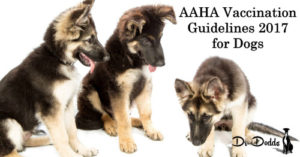AAHA recently released its latest vaccination guidelines for dogs. The association’s primary vaccination protocol has been slightly changed since the last revision in 2011. These updates, while not readily apparent, are still significant. Before we delve into those changes, let’s review the core vaccination protocol compared to the one I recommend. [Note: Rabies vaccines and vaccinations are regulated by law. So, it is not in the comparison.]
AAHA’s Core Vaccination Protocol
Core Vaccines
- Canine Distemper Virus
- Parvovirus
- Adenovirus-2
- OPTIONAL Parainfluenza Virus
Vaccine Timing
- Beginning as early as 6 weeks of age, administer sequential doses of a combination vaccine at an interval of 2 to 4 weeks until at least 16 weeks of age. Dogs residing in a HIGH-RISK environment may benefit from receiving a final dose at 18 to 20 weeks of age.
- Administer a single dose of a combination vaccine within 1 year following the last dose in the Initial Vaccination series.
- Administer subsequent boosters at intervals of 3 years or longer.
- Measuring antibody levels (quantitative or qualitative) provides a reasonable assessment of protective immunity against CDV, CPV, and CAV2.
Core Vaccination Protocol I Recommend
9 – 10 Weeks of Age
- Distemper
- Parvovirus
14 – 15 Weeks of Age
- Distemper
- Parvovirus
18 weeks of age
- Parvovirus only
Note: New research states that last puppy parvovirus vaccine should be at 18 weeks old.
1 Year After Last Vaccination (Optional Booster)
- Distemper
- Parvovirus
If the client decides not to give this optional booster, run a serum antibody titer instead. If the client intends to just retest serum antibody titers in another three years, this optional booster at puberty is wise to give for more assured protection.
Perform vaccine antibody titers for distemper and parvovirus every three years thereafter, or more often, if desired.
Comparison of Core Vaccination Protocols
Titers
The most significant change AAHA has made is on its position on antibody titer testing. Bear in mind that it is not a recommendation or an endorsement of titer testing in lieu of the three-year vaccination series of distemper, parvovirus and adenovirus. If this were the case, titers would be listed on AAHA’s official protocol. However, it is an admission by AAHA that titer tests are alternatives to vaccination. The proof is on the website. In-depth diagnostic web pages are provided to veterinarians. Additionally, the pet caregiver section mentions the titer test alternative on the main vaccination guidelines webpage.
Titers, or quantitative antibody testing, can help determine your dog’s protection from some diseases. Titer testing can be useful when a dog’s vaccination history for distemper, adenovirus, and parvovirus is unknown—a positive result typically means he is considered protected. However, no test is 100% accurate, so in areas where these diseases run rampant, your veterinarian may still recommend vaccinating. While titer testing for rabies is available, the law still requires that the dog be vaccinated since this is a fatal, zoonotic (i.e., can be spread to people) disease.
This is definitely wonderful news and a positive step forward.
Timing
As you probably noticed, the vaccination protocol I recommend is more specifically scheduled compared to that of the AAHA guidelines. In my opinion, the AAHA guideline needs to tighten up its protocol timeline so our companion dogs can avoid adverse vaccine reactions and not risk the possibility of contracting parvovirus and distemper.
It is universally accepted that maternally derived antibodies are transferred to puppies when they receive colostrum milk from their dam only in the first 36 hours of life. After that, even though the breast milk contains many antibodies as well as wholesome nutrients, these antibodies can no longer cross the neonatal intestinal mucosal lining. The colostrum–derived antibodies gradually wane from birth over the next three months and most are gone by the age of 14-16 weeks. Until then, what remains in their bodies are called “residual maternal antibodies”, which are present in decreasing amounts to help protect the pup against foreign substances and infectious diseases.
Vaccinating these youngsters at too young of an age – when they have plenty of residual maternal immunity – just causes the vaccine antigen(s) to be partially neutralized so that full immunization is not achieved. Thus, the effect of vaccination is incomplete and the puppies are still at risk of getting one or more of these diseases, until the vaccine series is completed once the maternal antibodies have disappeared.
This is why the vaccination protocol I recommend starts at 9 weeks of age – the age when maternally derived antibodies start to wane. Exceptions do exist, but they are rare, namely:
- An impregnated rescue dog that has no known exposure to distemper or parvovirus. Vaccination history is unknown.
- The mother rejected the litter and pups did not nurse.
- The mother had no milk or sadly died during birth.
In these rare instances, I agree with the AAHA guidelines to start a parvovirus vaccination protocol at 6 weeks of age. Both AAHA and I agree that vaccinations for canine distemper should never be given to pups at or less than 6 weeks of age as they can cause post-vaccinal encephalitis (PVE) that resembles natural distemper.
Adenovirus
At the current time, I do not recommend routinely giving the adenovirus (CAV-2) vaccination for either infectious canine hepatitis (ICH) or kennel cough. In the United States, there has only been one documented and isolated domesticated dog ICH incident in the past fifteen years. If and when a true outbreak does happen, my vaccination protocol can be revised appropriately to include CAV-2 vaccination to cover ICH for a specific region.
Parainfluenza
Parainfluenza is simply a member of the kennel cough complex. By itself, canine parainfluenza produces mild to moderate upper respiratory disease or no discernable clinical disease. When parainfluenza virus is combined with a bacterium such as Bordetella and several other potential viral pathogens, kennel cough could result. So, the attempt to pin down canine parainfluenza to specific respiratory lesions is difficult within the kennel cough complex. The current oral or intranasal Bordetella vaccines also cross protect against the other organisms in the kennel cough complex, including the CAV-2, discussed above. Plus, the vaccine needs to be reevaluated and be subjected to new clinical trials. The last one was conducted in the early 2000’s.
Notable Guidelines
Mixing Vaccines
According to AAHA’s website regarding mixing vaccines:
Can different vaccines (not part of a single commercial product) be administered to the same dog at the same appointment?
Yes. Different vaccine types can be administered to the same patient at the time of the appointment. When feasible, they should be administered into separate sites that are drained by different lymph nodes. For example, if a combination modified-live virus (attenuated) vaccine (such as, canine distemper virus (CDV), canine adenovirus-2 (CAV2), canine parvovirus (CPV)) is administered subcutaneously (SQ) over the left shoulder, a killed (inactivated) leptospirosis or rabies vaccine could be administered SQ over the right shoulder.
Actually, I strongly disagree with this approach. Almost all vaccine vials or sprays contain additional and necessary ingredients to make sure the vaccine “takes” in the body. For example, adjuvants are present in all inactivated killed product vaccines. These are substances that are added to vaccines to enhance the body’s immune response to the vaccine antigen(s). As stated above, the intranasal and oral Bordetella vaccines induce the body to secrete alpha-interferon, an immune protein that affords cross protection against the other viruses in the kennel cough complex. When you add too many vials and/or sprays together all at once, the likelihood of an adverse vaccine reaction increases.
For instance, I recommend the two-way combined vaccine against distemper and parvovirus. Many clients wish to give individual, monovalent canine parvovirus and canine distemper vaccines. In this situation, they should be given in alternating fashion every 2 weeks starting with the canine parvovirus vaccine – as this disease is much more prevalent than canine distemper.
Regarding rabies vaccine, it should be spaced a minimum of 3-4 weeks apart from other vaccines, as it presents the strongest antigenic challenge to the immune system.
Shelter Dogs
AAHA’s 2011 Vaccination Guidelines state:
Dogs with a Documented Vaccination History at Time of Admission
There is no compelling reason to administer vaccines to an individual dog at the time of admission to a shelter if clear documentation confirms current vaccination administered after the age of 16 wk is provided. The following is the minimum information acceptable as documenting proof that a valid vaccination has been administered:
- Proprietary name of product
- Manufacturer name
- Serial/lot number
- Date vaccine was administered (at least month and year)
- Expiration date of vaccine administered
- Signature of a licensed veterinarian
This information should be associated with a medical record that clearly describes the dog in question. If any of this information is not available at the time of admission or cannot be associated with a formal record for the dog, then immediate vaccination is indicated.
Surprisingly, this proviso from the earlier editions of AAHA’s Canine Vaccine Guidelines was not included in the current 2017 version. Granted, the majority of dogs admitted to shelters are not responsibly owner-relinquished.
On the bright side, the veterinary diagnostic section regarding titers includes the optional titer testing of dogs in shelters.
Conclusion
Overall, I applaud the American Animal Hospital Association (AAHA) for its transparency, website language, layout and tools that are very pet companion caregiver friendly. I particularly like the Lifestyle-Based Vaccine Calculator that helps pet parents determine if their pets need a lifestyle vaccination.
W. Jean Dodds, DVM
Hemopet / NutriScan
11561 Salinaz Avenue
Garden Grove, CA 92843

